Machu Picchu & The Sacred Valley
- jillrsherman
- Dec 6, 2022
- 9 min read

Machu Picchu has been on my bucket list since I learned about it in my 20s. We planned our trip through South America taking the ideal time to do the trek in mind - well, and to also catch an endless summer as we move south, as opposed to winter (since Zander was born in May and it is winter in South America then). A limited number of trekkers and porters can climb the mountain each day, so we had to plan this a bit more in advance. Tourism hasn’t totally recovered from Covid yet, so we didn’t need to book 6 months in advance, which is in our favor because we barely plan a few days ahead - we just go where we want, when we want.
I dreamed of doing the 4-day Inca Trail with the kids. But the Quilotoa hike in Ecuador somewhat scarred us - both Imogen and Zander need to be carried plus food and layers for the cold, so Jonah and I have an extra 30 - 40 pounds on each of us as we climb up the mountain to the famous citadel. We, therefore, opted for the 2-day excursion - 1 day of hiking to Machu Picchu and the next day exploring the ruins. Everyone has to take a guide - but since it is low season we were lucky to be the only ones on our tour.
The adventure starts with a train ride into the “high jungle” where you see the terrain change from cold and dry to warm with lush vegetation. Once we left behind the glacier-capped Nevado Veronica, the mountains turned into those famous karst-like rounded mountains of the Peruvian jungle. We got dropped off in the middle of it at km 104 with nothing around except a checkpoint and the trail.
On the train to Machu Picchu and starting on km 104.
We covered ourselves in lotion and bug spray and then started the steep climb up. The first part is the hardest - and somewhat zapped Dashiell’s energy. It’s hard to push an 8-year-old up a steep mountain when he knows that there are 10 miles to go. But as the trail started to become less of an incline and other walkers cheered us on, his enthusiasm reappeared.
The entire walk is really rewarding; the scenery is gorgeous and grows more beautiful the further you go. We walked through clouds, fog, rain, and eventually sun.
The trail takes you through various Incan ruins along the way and our guide explained the history as we hiked.
The Inca ruins of Winawayna - about halfway through the hike.
Along the way we enjoyed a nice waterfall to wash off the sweat and keep us cool. No matter how long we hike and how much the kiddos complain about the length of a hike, they always have energy to climb on rocks.
This is the shoulder season, so we didn’t know if we would even get to see the citadel due to cloud coverage. The storm clouds rolled in and rain started to fall - we anxiously kept going, hoping to catch a clear view of the ruins at the end.
The most steep part of the hike is the last bit right at the top as you approach the citadel. Jonah called this the "Inka escalator." We raced each other to the top.
These steps do not look as steep as they are in reality!
Imogen loved it too, and would hop off of Jonah’s shoulder’s to join us as we hiked. I wish that I had a video of her excitedly chanting as we neared the top.
Our slow pace played out perfectly. As we came closer to the top of the mountain the clouds parted, clearing the way for a picture-perfect view of Machu Picchu! We arrived just in time for the soft color of the sunset as it started to dip below the horizon.

Of course, we had to take a ton of those very Instagramable photos at the top. Lucky for us, not many people were there at this time, so the view was all ours!
Push the arrow on the right to see a slideshow of our favorite pics.
The next day was our tour of the actual ruins. It was a hot day and there was very little shade. The kiddos were bored by the stories of the Incas. To be honest, the stories were very repetitive - the Incas did not have a written language so very limited information is passed down. Each site we went to throughout our trip had the same stories retold. So, they started inventing games to play and running around. These are the moments when my heart melts - it is awesome seeing them play together and Imogen is finally at a fun age for Dashiell.
Racing each other inside the ruins.
Machu Picchu is endlessly photogenic. It’s hard to capture all of the beauty there in an iPhone camera - next time we go on a long trip, I’m bringing a professional camera.
The Sacred Valley
I love the name of the area surrounding Cusco - The Sacred Valley. It is so my mystical and mysterious. The land is dotted with Incan ruins beside the Rio Urubamba and the traditional way of life. While traveling between ruins you see Andean weaving villages, artisanal markets, and salt mines.
For our time in Cusco, we left Bishi (the car) behind in Lima, so we were traveling by foot - we were now backpackers instead of overlanders!
Ollantaytambo

The ruins of Ollantaytambo - which sit right beside the village.
We started in Ollantaytambo, where the large ruins sit within the current village. After a full day at Machu Picchu and the train ride back, we arrived in Ollantaytambo after the sun set. We had booked a sweet hotel just outside the town and crammed all 5 of us into a teeny, tiny tuktuk to get us there. I wish that I had a recording of us in this tuktuk - the weight of us, the metal scraping against the wheels, the engine desperately gasping for air as we made our way up a little hill to this tiny hotel. We didn't think that the tuktuk would get us there.

These are the Peruvian tuktuks. All 5 of us were crammed in the backseat passenger cabin. We were laughing so hard the whole time.
We got dropped off where where the hotel told us to go, only to find that it was the wrong location. Starving and frustrated, we called the hotel, who eventually found us by foot and brought us to the hotel. This was long past dinner time, so we ordered food to be delivered and the hotel made us a bonfire with marshmellows to enjoy the evening. A glass of wine never tasted so good!
We woke up to see the ruins and town of Ollyantaytambo. This was once a fortress and a temple. There are sweeping views of ancient times beside “modern” life. I put modern in quotes because the town still feels like a relic of old times. This is one of the only places where the Spanish lost a major battle against the Incans. Soon thereafter, though, the Spanish returned with 4x the cavalry and gunpowder, sending the Incas to the jungle for safety.
It is amazing how quickly the Incas were subjected to the Spanish. Half due to small pox and infighting before the Spanish came along. Then due to fire arms vs. bows and arrows when the Spanish arrived. The Incas were only around for 500 years. The Spanish for 300 years. And post-colonial for 200 years.
Moray

Next we explored the perfect Incan circles of Moray. These are truly impressive circular terraces - I’ve never seen circular terraces before, have you? There are many different theories about the true purpose of these terraces. One commonly believed theory is that they were used as a lab for farming. From the top terrace to the bottom, there is a difference of 9 degrees Fahrenheit due to its orientation with he sun and wind. Soil samples have been found from different regions around Peru, so this is the most widely agreed upon theory - however there is no good source of water for the terraces, so not all agree on this theory. Another one is that these were ceremonial terraces.
The Salt Mines of Moras
These were really cool, and a nice break from a week of ruins.
According to UNESCO, “The Salt Mines of Maras are one of the largest salt extraction centers of prehispanic origin in the region of Cusco and of the current territory of Peru.”

The mines are in the middle of a sloped hill, with their brilliant white color contrasting the brown mountains within which they sit. Our mouths all dropped when we first saw the salt terraces - they are beautiful! The retaining walls of the 4,500 wells are made out of stone seated with mud mortar. They are fed with a natural saltwater spring and are harvested once a month.
I love these little captured moments of Imogen singing. All day long she sings little songs to us in the car. Sometimes they are nonsensical. Usually they are of things which were recently said and then repeated. You think that she isn't paying attention to us talking in the front seat until you hear your most recent statements in a song.
Pisac
Our last stop in the Sacred Valley was Pisac. We heard that this was a little hippie town and a bit too New Age … but we found this to be the best of the Sacred Valley towns. Sitting deep within a valley, the cobblestone streets boast rural life, Inca architecture and a cultural vibe of indigenous people wearing their traditional garments. This is also home to one of the largest artisanal markets in the region on Sundays.
We strolled the streets and enjoyed watching the people live their lives within the town.
I don’t know how a 3-year-old is influenced by fairy tales and princesses when we have none of it at home, but Imogen has been obsessed with finding a princess dress, so we took this opportunity to buy her a “princess skirt.”

Imogen in her native "princess" skirt - it's waaay too big and will fit her for years of playtime.
Dashiell was the same - somehow he got wind of superheros at the age of 3 and didn’t stop wearing costumes for 5 years. This is the first trip where we don’t have a packing cube filled with The Flash, Batman, and Spiderman costumes!
--------
After hearing the same stories each site and touring Machu Picchu - we were "ruined from ruins," in Jonah's words. My data scientist husband wants more facts and less stories. So, since we started to feel jaded, it was time to go back to Lima to find Bishi and be on our way. But before doing so, we explored the gorgeous city of Cusco.
Cusco

The main square of Cusco.
This is the golden gem of Peru, where all travelers pass through on their way to Machu Picchu and The Sacred Valley. It is easy to get lost strolling the cute streets with an endless array of boutiques, cafes, and restaurants. While it is covered in tourists, this is a real Peruvian city and you can sit back and watch real life walk by. I woke up early to stroll the square and watch kids walk to school with their parents, funerals and processions march to church, and locals stopping at the morning carts for quinoa breakfast.
Throughout our trip, the central markets have always been my favorite place to buy fruits, veggies, almuerzo set lunch meals, and people watch. The San Pedro central market is - by far - the most organized market that I have ever seen. Turns out it that the construction was directed by Gustav Eiffel (of the Eiffel tower) - although you wouldn't know it by its looks. We spent a lot of time in this market getting juice, artisinal crafts, and lots of Peruvian ceviche!
The city was even more special from the incredible view of our glass-box apartment that we rented.

We spent days just wandering the streets and enjoying food, people-watching, and taking it easy for a couple of days.
Jonah's thoughts of Machu Picchu and The Sacred Valley:
One of the most anticipated treks of our journey. Enjoyed the trek. The price of the train tickets are preposterous, which therefore makes the trek to any Machu Picchu tour overly expensive. It was interesting to get off the train in the middle of nowhere to start the trek. It was nice to see a German group with 4 families and 8 kids start the trek with us - Germans like to hike. (We beat them to the top = but their kids had to walk the whole way, which was impressive. We carried The Littles.)
The terraces that we walked through are the “Inka escalator”. Lots of people want to do the 4-day trek. I’m happy that we did the 2-day trek, not because of the kids, but because of the amount of bug bites that we saw on people on the 4-day trek.
Coming into view of Sun God Gate was a fantastic reward for the long hike. And because we were so slow, the whole place was empty, which was also nice.
All of the guides go to school for 4 years to become eligible to be guides and learn the history, plus speak at least 1 foreign language. It was sad to hear how poorly the sherpas are paid compared to the guides.
(Recent laws were just passed limiting the loads that they can carry - they used to max out at 60 kilo per person, and now it is 20 kilo max - and only make around $20/day. We didn’t have a sherpa since we were only doing one overnight, so we carried our own food and stuff - a full change of clothes is overrated, anyway, right?!)



















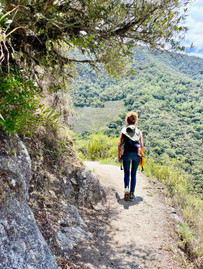













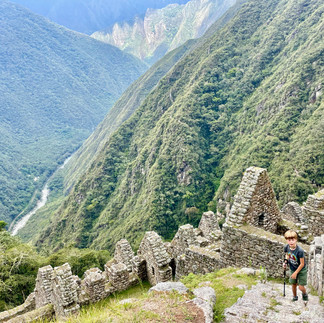
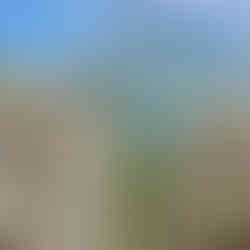
















































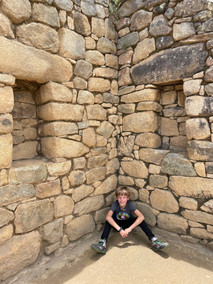























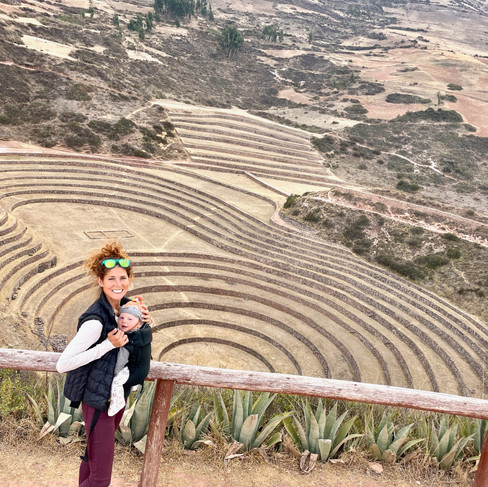









































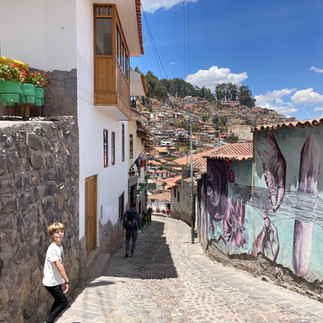





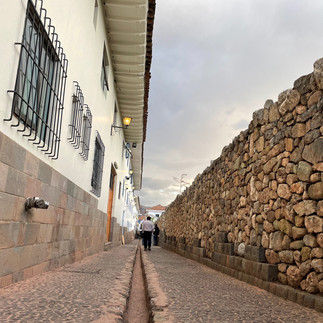












Comments